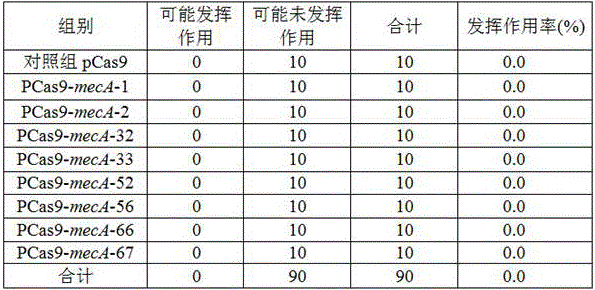Method for eliminating mecA plasmids based on CRISPR/Cas9 technology
A t-pmd19-meca, plasmid technology, applied in the field of molecular biology, can solve the problems of limited development, not widespread, and poor effect of Staphylococcus aureus
- Summary
- Abstract
- Description
- Claims
- Application Information
AI Technical Summary
Problems solved by technology
Method used
Image
Examples
Embodiment Construction
[0059] The features of the present invention and other relevant features are described in further detail below through the embodiments, so as to facilitate the understanding of those skilled in the art:
[0060] The CRISPR / Cas9 technology provided by the present invention eliminates mecA The method for the plasmid comprises the following steps:
[0061] (1) DNA template preparation
[0062] DNA was extracted from MRSA mel-stap-a2014124 / zz strain using bacterial genomic DNA extraction kit;
[0063] (2) mecA Gene PCR amplification
[0064] Selection of MRSA strain pairs mecA The DNA sequence encoding the C-terminus of transpeptidase is amplified by PCR;
[0065] Among them, the amplification primers are:
[0066] F: CGGGATCCACTATTGATGCTAAAGTTCAAAAG
[0067] R:CCCAAGCTTATCATCTATATCGTATTTTTTATTA;
[0068] The PCR amplification system includes: 12.5 μl of 2×Taq PCR Master Mix, 1 μl of amplification primer F, 1 μl of amplification primer R, 2 μl of MRSA DNA, and 8.5 μl of...
PUM
 Login to View More
Login to View More Abstract
Description
Claims
Application Information
 Login to View More
Login to View More - R&D
- Intellectual Property
- Life Sciences
- Materials
- Tech Scout
- Unparalleled Data Quality
- Higher Quality Content
- 60% Fewer Hallucinations
Browse by: Latest US Patents, China's latest patents, Technical Efficacy Thesaurus, Application Domain, Technology Topic, Popular Technical Reports.
© 2025 PatSnap. All rights reserved.Legal|Privacy policy|Modern Slavery Act Transparency Statement|Sitemap|About US| Contact US: help@patsnap.com



